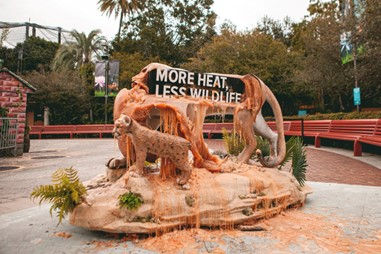Art has long served as a powerful platform for driving social and political change. Today, with the urgent threat of climate catastrophe looming, artists around the world are harnessing their creativity to call attention to environmental decline through impactful works across mediums. By immersing audiences in environmental themes and imagery, these compelling climate-focused artworks aim to educate, incite emotion, inspire action and offer glimpses of a more harmonious future between humanity and nature.
Melting Panthers, Bob Partington

American sculptor Bob Partington unveiled a chilling waxwork sculpture in September 2021, at a Florida zoo. The sculpture is meant to sound the alarm on climate change.
At first, the life-like wax figures appeared benign - a Florida panther mother tenderly watching over her cub. But as the Florida heat mercilessly beat down, the wax bodies began to twist and melt before horrified onlookers. As the panther mother's form deteriorated, a disturbing message emerged carved into her distorted body: "More heat, less wildlife."
Partington partnered with climate education group CLEO Institute to create the unsettling artwork as a stark warning about the imminent threats climate change poses to Florida's precious but vulnerable ecosystems and wildlife. By utilizing visual metaphor and allowing the natural elements themselves to "damage" the beautiful waxwork, Partington aimed to underscore how rising temperatures, extreme weather, flooding and habitat loss are already impacting the region. The visceral sculpture and its disfiguration by the blazing Florida sun serve as an ominous cautionary tale - without urgent action to curb climate change, even more of the state's irreplaceable native species and landscapes could soon warp and vanish just as quickly as the delicate wax panther under the intensifying heat.
Birds Watching, Jenny Kendler

Environmental artist Jenny Kendler's haunting sculpture "Birds Watching" conveys a warning from the avian world. The massive 40-foot artwork features row upon row of intricately carved eyes belonging to 100 different bird species endangered by climate change. The multitude of unblinking stares peer down at the viewer, silently imploring us to consider how human-caused environmental devastation threatens their very survival.
Kendler was inspired to create the piece after a 2014 Audubon Society report identified 389 North American bird species vulnerable to extinction from climate impacts. Habitat loss, rising temperatures, wildfires and floods have all taken an alarming toll on avian populations. Updated in 2022, the report underscores how time is running out to save these fragile species teetering on the brink.
Yet her sculpture also hints at the hope that taking immediate action could still preserve vulnerable birds and their ecosystems. Kendler chose to depict the steady, soulful eyes of the birds as both a plea for help and a sign of resilience, if humanity chooses to heed nature's alarm calls resonating through her arresting artwork.
Ice Watch, Olafur Eliasson

In his evocative public artwork "Ice Watch" (2014), artist Olafur Eliasson viscerally confronts audiences with the stark realities of climate change through the power of experiential metaphor.
Eliasson hauled 30 monumental blocks of ancient glacial ice from Greenland and displayed them to gradually melt away over days right outside London's Tate Modern and Bloomberg headquarters. Compelling passersby to physically engage with the frigid yet fragile ice forms before they disappeared, Eliasson aimed to make the abstract threat of global warming disturbingly tangible.
By starkly juxtaposing the raw power of elemental nature against the heart of urban modernity, the artist underscores an urgent wakeup call about the interdependence of humans and the environment. As the ice slowly melts under the uncaring sun, draining the life and history held within each flowing drop, viewers are left to grapple with our own melting time to save ecosystems and communities endangered by climate crisis.
Through such visceral works, Eliasson continues to harness arresting visual metaphors that can spark awareness and action against global warming's devastating ecological impacts occurring now worldwide.
The Transformative Power of Artistic Perspectives
From somber warnings to hopeful visions, art focused on ecological challenges can spark renewed reverence for our planet along with activism. By giving visual form to abstract threats and imagined futures, these compelling works make pressing issues vividly real, bridging the gap between passive awareness and engaged response. While the road ahead remains daunting, art that confronts climate breakdown holds power to galvanize audiences worldwide to demand change and work towards a restored environment for all living things.
Comments